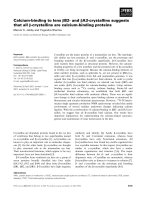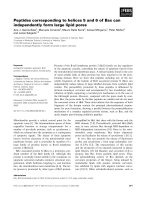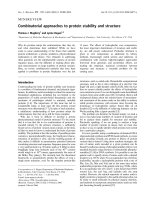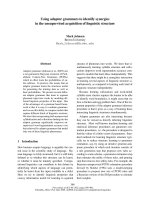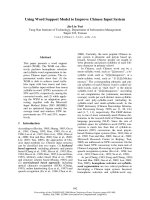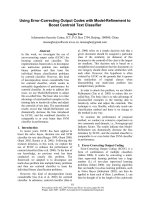Báo cáo khoa học: "Using Focus to Generate Complex and Simple Sentences" pot
Bạn đang xem bản rút gọn của tài liệu. Xem và tải ngay bản đầy đủ của tài liệu tại đây (654.01 KB, 8 trang )
Using
Focus to Generate Complex and Simple
Sentences
Marcia A. Derr Kathleen R. McKeown
AT&T Bell Laboratories
Murray Hill, NJ 07974 USA
and
Department of Computer Science
Columbia University
Department of Computer Science
Columbia University
New York, NY 10027 USA
Abstract
One problem for the generation of natural language
text is determining when to use a sequence of simple
sentences and when a single complex one is more
appropriate. In this paper, we show how focus of attention
is one factor that influences this decision and describe its
implementation in a system that generates explanations for
a student advisor expert system. The implementation uses
tests on functional information such as focus of attention
within the Prolog definite clause grammar formalism to
determine when to use complex sentences, resulting in an
efficient generator that has the same benefits as a
functional grammar system.
1. Introduction
Two problems in natural language generation are
deciding what to say and how to say it. This paper
addresses issues in the second of these tasks, that of
surface generation. Given a semantic representation of
what to say, a surface generator must construct an
appropriate surface structure taking into consideration a
wide variety of alternatives. When a generator is used to
produce text and not just single sentences, one decision it
must make is whether to use a sequence of simple
sentences or a single complex one. We show how focus of
attention can be used as the basis on which this decision
can be made.
A second goal of this paper is to introduce a
formalism for surface generation that uses aspects of Kay's
functional grammar (Kay, 1979) within a Prolog definite
clause grammar (Pereira and Warren, 1980). This
formalism was used to implement a surface generator that
makes choices about sentence complexity based on shifts in
focus of attention. The implementation was done as part
of an explanation facility for a student advisor expert
system being developed at Columbia University.
2. Language Generation
Model
In our model of natural language generation, we
assume that the task of generating a response can be
divided into two stages: determining the semantic content
of the response and choosing a surface structure I. One
component makes decisions about which information to
include in the response and passes this information to a
surface generator. For example, an expert system
explanation facility may select part of the goal tree, a
particular goal and its antecedent subgoals, to explain a
behavior of the system. In the advisor system, the output
of this component consists of one or more logical
propositions where each proposition consists of a predicate
relating a group of arguments. The output includes
functional information, such as focus, and some syntactic
features, such as number and tense, for convenience.
Other information, such as the relationships between
propositions, is implicit in the organizational structure of
the output.
The output of the semantic component is passed on
to another component, the surface generator. The job of
generator is to use whatever syntactic and lexical
information is needed to translate the logical propositions
into English. The generator must be able to make choices
concerning various alternatives, such as whether to
use
active or passive voice, or when to pronominalize. While
we have found the explanation facility for the advisor
system to be a valuable testbed for the surface generator,
the generator is an independent module that can be
transported to other domains by changing only the
vocabulary.
3. Choosing Surface Structure
Given a set of propositions, one decision a surface
generator must make is whether to produce a simple
sentence for each proposition or whether to combine
propositions to form complex sentences. As an example,
consider propositions 1 and 2 below. These may be
expressed as two simple sentences (sequence l) or as one
sentence containing a subordinate clause (sentence 2).
The sentences in 1 and 2 also show that a generation
system should be able to choose between definite and
indefinite reference and decide when to pronominalize.
Another decision is what syntactic structure to use, such as
1.
In order to concentrate on the task of surface generation, these
two
stages are totally separate in our system, but we doN't dispute
the
value of interaction between the two (Appclt, 1983).
319
whether to use the active or the passive voice. Thus,
proposition l may be expressed as any of the sentences
shown in 3-5.
proposition 1:
1.
2.
3.
4.
5.
predicate=give
protagonist~John
goal '~ book
beneficiary~Mary
John gave Mary a book.
Mary needed the book.
proposition 2:
predicate-need
protagonist -Mary
goal = book
John gave Mary a book that she needed.
John gave Mary a book.
Mary was given a book by John.
A book was given to Mary by John.
Given that there are multiple ways to express the
same underlying message, how does a text generator
choose a surface structure that is appropriate? What are
some mechanisms for guiding the various choices?
Previous research has identified focus of attention as one
choice mechanism. McKeown (1982) demonstrated how
focus can be used to select sentence voice, and to
determine whether pronominalization is called for. In this
paper, we will show how focus can also be used as the
basis on which to combine propositions.
3.1 Linguistic Background
Grosz (1977) distinguished between two types of
focus:
global
and
immediate.
Immediate focus refers to
how a speaker's center of attention shifts or remains
constant over two consecutive sentences, while global focus
describes the effect of a speaker's center of attention
throughout a sequence of discourse utterances on
succeeding utterances. In this paper, when we refer to
"focus of attention," we are referring to immediate focus.
Phenomena reflecting immediate focus in text have
been studied by several linguists. Terminology and
definitions for these vary widely; some of the names that
have emerged include topic/comment, given/new, and
theme/rheme. These linguistic concepts describe
distinctions between functional roles elements play in a
sentence. In brief, they can be defined as follows:
• Topic:
Constituents in the sentence that
represent what the speaker is talking about.
Comment labels constituents that represent
what s/he has to say about that topic (see
Sgall, Hajicova, and Benesova, 1973; Lyons,
1968; Reinhart, 1981).
• Given:
Information that is assumed by the
speaker to be derivable from context where
context may mean either the preceding
discourse or shared world knowledge. New
labels information that cannot be derived
(see Halliday, 1967; Prince, 1979; and
Chafe, 1976).
• Theme:
The Prague School of linguists (see
Firbas, 1966; Firbas, 1974) define the theme
of a sentence as elements providing common
ground for the conversants. Rheme refers to
elements that function in conveying the
information to be imparted. In sentences
containing elements that are contextually
dependent, the contextually dependent
elements always function as theme. Thus,
the Prague School version is close to the
given/new distinction with the exception that
a sentence always contains a theme, while it
need not always contain given information 2.
What is important here is that each of these
concepts, at one time or another, has been associated with
the selection of various syntactic structures. For example,
it has been suggested that new information and rheme
usually occur toward the end of a sentence (e.g., Halliday,
1967; Lyons, 1968; Sgall et al., 1973; Firbas, 1974). To
place this information in its proper position in the
sentence, structures other than the unmarked active
sentence may be required (for example, the passive).
Structures such as
it-extraposition, there-insertion,
3
topicalization,
and
left-dislocation
have been shown to
function in the introduction of new information into
discourse (Sidner, 1979; Prince, 1979), often with the
assumption that it will be talked about for a period of time
(Joshi and Weinstein, 1981). Pronominalization is another
linguistic device associated with these distinctions (see
Akmajian, 1973; Sidner, 1979).
One major difference between linguistic concepts
and immediate focus is that focusing describes an active
process on the part of speaker and listener. However, the
speaker's immediate focus influences the surfacing of each
of the linguistic concepts in the text. It influences topic
(and Halliday's theme) in that it specifies what the
speaker is focusing on (i.e., talking about) now. But it
also influences given information in that immediate focus
is linked to something that has been mentioned in the
previous utterance and thus, is already present in the
reader's consciousness. Since immediate focus is
intimately related to the linguistic definitions of functional
information, the influence of functional information on the
surface structure of the sentence can be extended to
immediate focus as well.
2. Halliday also discusses theme (Halliday, 1967), but he defines
theme as that which the speaker is talking about now, as opposed
to given, that which the speaker
was
talking about. Thus, his
notion of theme is closer to the concept of topic/comment
articulation. Furthermore, Halliday always ascribes the term
theme to the element occurring first in the sentence.
3. Some examples of these constructions are:
I. It was Sam who left the door open. (it-extraposition)
2. There are 3 blocks on the table. (there-insertion)
3. Sam, I like him. (left-dislocation)
4. Sam I like. (topicalization)
320
3.2 Focus and Complex Sentences
While previous research in both linguistics and
computer science has identified focus as a basis for
choosing sentence voice and for deciding when to
pronominalize, its influence on selecting complex sentence
structure over several simple sentences has for the most
part gone unnoticed. If a speaker wants to focus on a
single concept over a sequence of utterances, s/he may
need to present information about a second concept. In
such a case, a temporary digression must be made to the
second concept, but the speaker will immediately continue
to focus on the first. To signal that s/he is not shifting
focus, the speaker can use subordinate sentence structure
in describing the second concept.
Suppose that, in the previous example, focus is on
John in proposition 1 and book in proposition 2. If a third
proposition follows with focus returning to John, then the
surface generator can signal that the shift to book is only
temporary by combining the two propositions using
subordination as in sentence 2. A textual sequence
illustrating this possibility is shown in 6 below. On the
other hand, if the third proposition continues to focus on
book, then it is more appropriate to generate the first and
second propositions as two separate sentences as in
sentence 1 above. It may even be possible to combine the
second and third propositions using coordination as in the
textual sequence shown in 7 below.
6. John gave Mary a book that she needed.
He had seen it in the Columbia bookstore.
7. John gave Mary a book.
Mary needed the book and had been planning
on buying it herself.
Argument identity can also serve with focus as a
basis for combining propositions as shown in the example
below. In proposition 3, the values of predicate,
protagonist, and focus match the values of the
corresponding arguments in proposition 4. Thus, the two
propositions can be joined by deleting the protagonist and
predicate of the second proposition and using conjunction
to combine the two goals as in sentence 8. Note that if
the focus arguments were different, the propositions could
not be combined on this basis. Propositions 5 and 6, with
matching values for focus can also be combined by using
coordination and deleting the focused protagonist in the
second proposition (sentence 9).
proposition 3:
predicate
=
buy
protagonist - John
goal -" book
focus - John
proposition 5:
predicate read
protagonist = Mary
goal = book
focus = Mary
proposition 4:
predicate
=
buy
protagonist John
goal cassette
focus "~ John
proposition 6:
predicate - play
protagonist = Mary
goal = cassette
focus = Mary
8. John bought a book and a cassette.
9. Mary read the book and played the cassette.
4. A Formalism for Surface Generation
In this section we discuss the Prolog definite clause
grammar (DCG) formalism (Pereira and Warren, 1980)
and how it can be used for language generation, as well as
recognition. We then review the functional grammar
formalism (Kay, 1979) that has been used in other
generation systems (e.g., McKeown, 1982; Appelt, 1983).
Finally, we describe how aspects of a functional grammar
can be encoded in a DCG to produce a generator with the
best features of both formalisms.
4.1 Definite Clause Grammars
The DCG formalism (Pereira and Warren, 1980) is
based on a method for for expressing grammar rules as
clauses of first-order predicate logic (Colmerauer, 1978;
Kowalski, 1980). As discussed by Pereira and Warren,
DCGs extend context-free grammars in several ways that
make them suitable for describing and analyzing natural
language. DCGs allow nonterminals to have arguments
that can be used to hold the string being analyzed, build
and pass structures that represent the parse tree, and carry
and test contextual information (such as number or
person). DCGs also allow extra conditions (enclosed within
brackets '{' and '}') to be included in the rules, providing
another mechanism for encoding tests. A simple sentence
grammar is shown in Figure 1.
Viewed as a set of grammar rules, a DCG functions
as a declarative description of a language. Viewed as a set
of logic clauses, it functions as an executable program for
analyzing strings of the language. In particular, a DCG
can be executed by Prolog, a logic programming language
that implements an efficient resolution proof procedure
using a depth-first search strategy with backtracking and a
matching algorithm based on unification (Robinson, 1965).
To analyze a sentence, the sentence is encoded as an
argument to a Prolog goal. Prolog attempts to prove this
goal by matching it against the set of grammar clauses. If
the proof succeeds, the sentence is valid and a second
argument is instantiated to the parse tree structure. A
recognition goal and its resulting parse tree are shown in
Figure 1. More extensive examples can be found in
Pereira and Warren (1980).
321
sentence(s(N P,VP)) >
n phrase(N P,N um),v phrase(VP,N urn).
n__phrase (np (Noun),N urn) >
noun(Noun,Num).
noun(n(Root,Num),Num) >
[the], [Word], {is_noun(Root,Word,Num)}.
v__phrase(vp(Verb,NP),Num) >
verb(Verb,Num), n__phrase(N P,N2).
verb (v (Root, N u m ,Tense), N u m) >
[Word], {is verb (Root,Word,N urn,Tense) }.
is_noun (student,student,singular).
is_noun (student,students,plural).
is_noun (answer,answer,singular).
is_noun (answer,answers,plural).
is__verb (give,gives,singular,pres)
is_ver b (give,give,plural,pres).
is_verb(give,gave, ,past).
Recognition Goal:
sentence (T,[the,student,gave,the,answer],[]).
Result:
T = s(np(n (student,singular)),
vp(v (give,singular,past),
np(n (answer,singular))))
Generation Goal:
sentence (s (np (n (student,singular)),
vp(v (give,singular,past),
np(n (answer,singular)))),S,[l).
Result:
S = [the,student,gave,the,answer]
Figure I. Language recognition and generation using a
DCG
While Pereira and Warren concentrate on
describing the DCG formalism for language recognition
they also note its use for language generation, which is
similar to its use for language recognition. The main
difference is in the specification of input in the goal
arguments. In recognition, the input argument specifies a
surface string that is analyzed and returned as a parse tree
structure in another argument. In generation, the input
goal argument specifies a deep structure and a resulting
surface string is returned in the second argument. Though
not always practical, grammar rules can be designed to
work in both directions (as were the rules in Figure 1). A
generation goal and the sentence it produces are shown in
Figure I.
4.2 Functional Grammars
Another formalism that has been used in previous
.generation systems (McKeown, 1982; Appelt, 1983) is the
functional grammar formalism (Kay, 1979) 4 . In a
functional, grammar, functional information such as
focus
and
protagonist
are treated in the same manner as
syntactic and grammatical information such as
subject
and
NP.
By using functional information, input to the
generator is simplified as it need not completely specify all
the syntactic details. Instead, tests on functional
information, that select between alternative surface
structures, can be encoded in the grammar to arrive at the
complete syntactic structure from which the string is
generated. This formalism is consistent with the
assumption that is part of our generation model: that one
generation component produces a semantic specification
that feeds into another component for selecting the final
surface structure.
In the functional grammar formalism, both the
underlying message and the grammar are specified as
functional descriptions, lists of attribute-value pairs, that
are unified 5 to produce a single complete surface structure
description. The text is then derived by linearizing the
complete surface structure description. As an example,
consider the proposition encoded as a functional
description below. When unified with a sentence grammar
that contains tests on focus to determine voice and order
constituents, sentence 12 is generated. If FOCUS were
<GOAL>, instead, sentence 13 would result.
CAT ~ S
PRED = [LEX = give]
TENSE = PAST
PROT [LEX = student]
GOAL = [LEX = answer]
BENEF = NONE
FOCUS = <PROT>
12. The student gave the answer.
13. The answer was given by the student.
Previous implementations of functional grammars
have been concerned with the efficiency of the functional
grammar unification algorithm. Straightforward
implementations of the algorithm have proved too time-
consuming (McKeown, 1982) and efforts have been made
to alter the algorithm to improve efficiency (Appelt, 1983).
Efficiency continues to be a problem and a functional
grammar generator that can be used practically has as yet
to be developed.
4.3 Combining the Formalisms
We have implemented a surface generator based on
both the DCG formalism and the functional grammar
4. Functional grammar has also been referred to as
unification
grammar
(Appett, 1983).
5. The functional grammar unification operation is similar to set
union. A description of the algorithm is given in Appelt (1983).
It is not to be confused with the unification process used in
resolution theorem proving, though a similarity has been noted by
Pereira and Warren (1983).
322
formalism. The result is a generator with the best features
of both grammars: simplification of input by using
functional information and efficiency of execution through
Prolog. Functional information, supplied as part of the
generation goal's input argument, is used by the grammar
rules to select an appropriate surface structure. The extra
conditions and context arguments allowed by the DCG
formalism provide the mechanism for testing functional
information.
Figure 2 shows a proposition encoded as the input
argument to a DCG goal. The proposition specifies, in
order, a predicate, protagonist, goal, beneficiary, and focus.
In this example, the focus argument is the same as the
protagonist. While the proposition also includes tense and
number information, less syntactic information is specified
compared to the input argument of the generation goal in
Figure 1. In particular, no information regarding
constituent order is specified. Also shown in Figure 2 are
some DCG rules for choosing syntactic structure based on
focus. The rules test for number agreement and tense, as
well. The
sentence
rule selects the focused argument as
the subject noun phrase. The
vp
rule determines that
focus is on the protagonist, selects active voice, and puts
the goal into a noun phrase followed by the beneficiary in
a to
prepositional phrase. Thus, the order of constituents
in the generated sentence is not explicitly stated in the
input goal, but is determined during the generation
process. The sentence that results from the given
proposition is shown at the bottom of Figure 2.
Generation Goal:
sentence(prop(pred (give, past),
arg(student, singular),
arg(answer, singular),
arg(nil, __),
arg(student, singular)),S,[]).
Rules:
sentence (prop(Pred,Prot,Goal,Bene, Foc)) >
np(Foc),
vp(Pred,Prot,Goal,Bene,Foc).
vp (pred (Verb,Tense),Prot,Goal,Bene,Prot) >
{gemum(Prot,Num)},
verb (Verb,Tense,Num,active),
np(Goal),
pp(to,Bene).
Result:
S m [the,student,gave,the,answer]
Figure 2. DCG rules that use focus to select syntactic
structure
5. Surface Generator Implementation
A surface generator, with mechanisms for selecting
surface structure and, in particular, combining
propositions, was implemented as part of an explanation
facility for a student advisor expert system which is
implemented in Prolog. One component of the advisor
system, the planner, determines a student's schedule of
courses for a particular semester. An explanation of the
results of the planning process can be derived from a trace
of the Prolog goals that were invoked during planning
(Davis and Lenat, 1982). Each element of the trace is a
proposition that corresponds to a goal. The propositions
are organized hierarchically, with propositions toward the
top of the hierarchy corresponding to higher level goals.
Relationships between propositions are implicit in this
organization. For example, satisfying a higher level goal is
conditional on satisfying its subgoals. This provides a rich
testbed on which to experiment with techniques for
combining propositions. Because the expert system does
not yet automatically generate a trace of its execution, the
propositions that served as input to the surface generator
were hand-encoded from the results of several system
executions. In the current implementation, the grammar is
limited to handling input propositions structured as a list
of antecedents (subgoals) followed by a single consequence
(goal).
A grammar for automatically generating
explanations was implemented using the formalism
described in the previous section. The grammar encodes
several tests for combining propositions. Based on
temporary focus shift, it forms complex sentences using
subordination. Based on focus and argument identities it
uses coordination and identity deletion to combine
propositions. The grammar also includes tests on focus for
determining active/passive sentence voice, but does not
currently pronominalize on the basis of focus.
The generator determines that subordination is
necessary by checking whether focus shifts over a sequence
of three propositions. A simplified example of a DCG rule
focshift,
that tests for this is shown in Figure 3. The
left-hand-side of this rule contains three input propositions
and an output proposition. Each proposition has five
arguments: verb, protagonist, goal, beneficiary, and focus.
If the first proposition focuses on
Focl
and mentions an
unfocused argument
Goall,
and if the second proposition
specifies
Goall
as its focus, 6 but in the third proposition
the focus returns to
Focl,
then the first and second
propositions can be combined using subordination. The
combined propositions are returned as a single proposition
in the fourth argument; the third proposition is returned,
unchanged, in the third argument. Both can be tested for
further combination with other propositions. A sample
text produced using this rule is shown in 14 below.
6. The right-hand-side of the rule contains a test to check that the
focus of the second proposition is different from the focus of the
first.
323
foc shift (
prop (Verbl, Protl, Goall, Benl, Focl),
prop (Verb2, Prot2, Goal2, Ben2, Goall ),
prop (Verb3, Prot3, Goal3, Ben3, Focl),
prop (Verbl, Protl,
np(Goall, prop(Verb2, Prot2, Goal2, Ben2, Goall )),
Benl, Focl))
{Goall \~= Focl }.
14.
Assembly Language
has a prerequisite that was taken.
Assembly Language
does not conflict.
Figure 3. Combining propositions using subordination
Other tests for combining propositions look for
identities among the arguments of propositions. Simplified
examples of these rules are
id del
and
focdel
in Figure 4.
According to
id_del,
if the -first and second proposition
differ only by the arguments
Goall
and
Goal2o
these
arguments are combined into one
Goal
and returned in the
third proposition. The result is a single sentence
containing a noun phrase conjunction as sentence 15
illustrates. The other rule,
foc_del,
specifies that if two
propositions have the same focus,
Foc,
and in the second
proposition, the focus specifies the protagonist, then the
two propositions can form a coordinate sentence, deleting
the focused protagonist of the second proposition. Instead
of returning a proposition,
foc_del
in its right-hand-side,
invokes rules for generating a compound sentence. Sample
text generated by this rule is shown in 16.
id del (
prop (Verb, Prot, Goall, Ben, Foe),
prop (Verb, Prot, Goal2, Ben, Foe),
prop (Verb, Prot, Goal, Ben, Foe))
{Goall \=" Goal2, append (Goall, Goal2, Goal)}.
foc del (
prop (Verbl, Protl, Goall, Benl, Foe),
prop (Verb2, Prot2, Goal2, Ben2, Foe))
sentence (prop (Verb I, Prot I, Goal 1, Ben 1, Foc) ),
[andl,
verb_phrase (Verb2, Prot2, Goal2, Ben2, Foe).
15. Analysis of Algorithms
requires
Data Structures
and
Discrete Math.
16. Introduction to Computer Programming
does not
have prerequisites and does not conflict.
Figure 4. Combining propositions using coordination and
identity deletion
The generator uses of the organization of the input
to show causal connectives. Recall that the input to the
generator is a set of propositions divided into a list of
antecedents and a single consequence that was derived by
the expert system. The generator can identify the
consequence for the reader by using a causal connective.
An explanation for why a particular course was not
scheduled is shown in 17. The antecedents are presented
in the first part of the explanation; the consequence,
introduced by
therefore,
follows.
17. Modeling and Analysis of Operating Systems
requires
Fundamental Algorithms, Computability and Formal
Languages,
and
Probability.
Fundamental Algorithms
and
Computability and
Formal Languages
were taken.
Probability
was not taken.
Therefore,
Modeling and Analysis of Operating
Systems
was not added.
6. Related Work in Generation
There are two basic classes of related work in
generation. The first class of systems makes use of
functional information in constructing the surface structure
of the text and has relatively little to say about how and
when to produce complex sentences. The second class of
work has addressed the problem of producing complex
sentences but does not incorporate functional information
as part of this decision making process.
Of the systems which make use of functional
information, three (Kay, 1979; McKeown, 1982; Appelt,
1983) have already been mentioned. Kay's work provides
the basis for McKeown's and Appelt's and emphasizes the
development of a formalism and grammar for generation
that allows for the use of functional information. Both
McKeown and Appelt make direct use of Kay's formalism,
with McKeown's emphasis being on the influence of focus
information on syntax and Appelt's emphasis being on the
development of a facility that allows interaction between
the grammar and an underlying planning component.
Nigel (Mann, 1983) is a fourth system that makes
use of functional information and is based on systemic
grammar (Hudson, 1974). A systemic grammar contains
choice points that query the environment to decide between
alternatives (the environment may include functional,
discourse, semantic, or contextual information). Mann's
emphasis, so far, has been on the development of the
system, on the development of a large linguistically
justified grammar, and on the influence of underlying
semantics on choices. The influence of functional
information on syntactic choice as well as the generation of
complex propositions are issues he has not yet addressed
within the systemic grammar framework.
Of previous systems that are able to combine simple
clauses to produce complex sentences, Davey's (1978) is
probably the most sophisticated. Davey's system is able to
recognize underlying semantic and rhetorical relations
between propositions to combine phrases using textual
connectives, also an important basis for combining
. propositions. His emphasis is on the identification of
contrastive relations that could be specified by connectives
such as
although, but,
or
however.
While Davey uses a
systemic grammar in his generator, he does not exploit the
324
influence of functional information on generating complex
sentences.
Several other systems also touch on the generation
of complex sentences although it is not their main focus.
MUMBLE (McDonald, 1983) can produce complex
sentences if directed to do so. It is capable of ignoring
these
directions when it is syntactically inappropriate to
produce complex sentences, but it can not decide when to
combine propositions. KDS (Mann, 1981) uses heuristics
that sometimes dictate that a complex sentence is
appropriate, but the heuristics are not based on general
linguistic principles. Ana (Kukich, 1983) can also
combine propositions, although, like Davey, the decision is
based on rhetorical relations rather than functional
information.
In sum, those systems that are capable of
generating complex sentences tend to rely on rhetorical,
semantic, or syntactic information to make their decisions.
Those systems that make use of functional information
have not investigated the general problem of choosing
between complex and simple sentences.
7. Future Directions
The current implementation can be extended in a
variety of ways to produce better connected text.
Additional research is required to determine how and when
to use other textual connectives for combining propositions.
For example, the second and third sentences of 17 might
be better expressed as 18.
18. Although
Fundamental Algorithms
and
Computability and Formal Languages
were taken,
Probability
was not taken.
The question of how to organize propositions and
how to design the grammar to handle various organizations
deserves further attention. In the current implementation,
the grammar is limited to handling input propositions
structured as a list of antecedents and a single
consequence. If propositions were organized in trees rather
than lists, as in more complex explanations, the use of
additional connectives would be necessary.
The grammar can also be extended to include tests
for other kinds of surface choice such as definite/indefinite
reference, pronominalization, and lexical choice. As the
grammar grows larger and more complex, the task of
specifying rules becomes unwieldy. Further work is
needed to devise a method for automatically generating
DCG rules.
8. Conclusions
We have shown how focus of attention can be used
as the basis for a language generator to decide when to
combine propositions. By encoding tests on functional
information within the DCG formalism, we have
implemented an efficient generator that has the same
benefits as a functional grammar: input is simplified and
surface structure can be determined based on constituents'
function within the sentence. In addition to producing
natural language explanations for the student advisor
application, this formalism provides a useful research tool
for experimenting with techniques for automatic text
generation. We plan to use it to investigate additional
criteria for determining surface choice.
Acknowledgments
We would like to thank Mitch Marcus for his
comments on an earlier version of this paper.
References
Akmajian, A. (1973), "The role of focus in the
interpretation of anaphoric expressions," In Anderson
and Kiparsky (Ed.),
Festschrifffor Morris Halle,
Holt,
Rinehart, and Winston, New York, NY, 1973.
Appelt, Douglas E. (1983), "Telegram: a grammar
formalism for language planning,"
Proceedings of the
21st Annual Meeting of the Association for
Computational Linguistics,
74-78, ! 983.
Chafe, W. L. (1976), "'Givenness, contrastiveness,
definiteness, subjects, topics, and points of view," In Li,
C. N. (Ed.),
Subject and Topic,
Academic Press, New
York, 1976.
Colmerauer, A. (1978), "Metamorphosis grammars," In
Bole, L. (Ed.),
Natural Language Communication with
Computers,
Springer, Berlin, 1978.
Davey, Anthony. (1978),
Discourse Production,
Edinburgh University Press, 1978.
Davis, Randall and Lenat, Douglas B. (1982),
Knowledge-Based Systems in Artificial Intelligence,
McGraw-Hill, New York, 1982.
Firbas, J. (1966), "On defining the theme in functional
sentence analysis,"
Travaux Linguistiques de Prague !,
University of Alabama Press, 1966.
Firbas, J. (1974), "Some aspects of the Czechoslovak
approach to problems of functional sentence
perspective,"
Papers on Functional Sentence
Perspective,
Academia, Prague, 1974.
Grosz, B.J. (1977), The representation and use of focus
in dialogue understanding. Technical note 151,
Stanford Research Institute, Menlo Park, CA, 1977.
Halliday, M. A. K. (1967), "Notes on transitivity and
theme in English,"
Journal of Linguistics,
3, 1967.
Hudson, R.A. (1974), "Systemic generative grammar,"
Linguistics,
139, 5-42, 1974.
Joshi, A. and Weinstein, S. (1981), "Control of inference:
role of some aspects of discourse structure - centering,"
Proceedings of the 7th International Joint Cot~erence
on Artificial Intelligence,
198 I.
Kay, Martin. (1979), "Functional grammar,"
Proceedings
of the 5th Annual Meeting of the Berkeley Linguistic
Society,
1979.
Kowalski, R.A. (1980),
Logic for Problem Solving,
North Holland, New York, NY, 1980.
Kukich, Karen. (1983), "Design of a knowledge-based
report generator,"
Proceedings of the 21st Annual
Meeting of the Association for Computational
325
Linguistics, 145-150, 1983.
Lyons, J, (1968), Introduction to Theoretical Linguistics,
Cambridge University Press, London, 1968.
Mann, W.A. and Moore, J.A. (1981), "Computer
generation of multiparagraph English text," American
Journal of Computational Linguistics, 7 (1), 17-29,
1981.
Mann, William C. (1983), "An overview of the Nigel text
generation grammar," Proceedings of the 21st Annual
Meeting of the Association for Computational
Linguistics, 79-84, 1983.
McDonald, David D. (1983), "Description directed
control: its implications for natural language
generation," Computers and Mathematics with
Applications, 9 (I), I 11-129, 1983.
McKeown, Kathleen R. (1982), Generating Natural
Language Text in Response to Questions about
Database Structure, Ph.D. dissertation, University of
Pennsylvania, 1982.
Pereira, Fernando C. N. and Warren, David H. D.
(1980), "'Definite clause grammars for language
analysis a survey of the formalism and a comparison
with augmented transition networks," Artilqcial
Intelligence, 13, 231-278, 1980.
Pereira, Fernando C. N. and Warren. David H. D.
(1983), "'Parsing as deduction," Proceedings of the
21st Annual Meeting o[ the Association for
Computational Linguistics. 137-144, 1983.
Prince, E. (1979), "On the given/new distinction," CLS,
15, 1979.
Reinhart, T. (1981), "Pragmatics and linguistics: an
analysis of sentence topics," Philosophica, 1981.
Robinson, J. A. (1965), "A machine-oriented logic based
on the resolution principle," Journal of the ACM, 12
(I), 23-41, 1965.
Sgall, P., Hajicova. E., and Benesova, E. (1973), Focus
and Generative Semantics, Scriptor Verlag, Democratic
Republic of Germany, 1973.
Sidner, C. L. (1979), Towards a Computation Theory of
Definite Anaphora Comprehension in English
Discourse, Ph.D. dissertation, MIT, Cambridge, MA,
1979.
326
